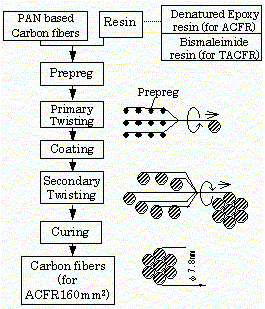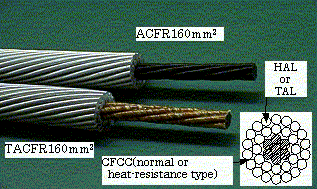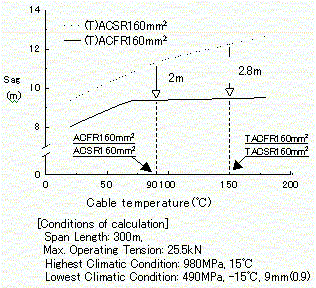HOME > Products > Energy Systems Field > Overhead Cable > Low sug aluminum conductor carbon fiber reinforced (ACFR)
Outline of Low-Sag Aluminum Conductor Carbon Fiber Reinforced
Summary
With its special carbon fiber core, ACFR conductors achieve both lighter weight and less liner expansion than a conventional ACSR, and display the following excellent characteristics:
- Securing the greatest clearance between conductor and ground level
- Increasing power transmission capacity and reducing conductor sag(ACSR⇒TACFR)
Advantages of Carbon Fiber

Fig. 1 Production process of CFCC
Carbon Fiber (CFCC: Carbon Fiber Composite Cable) used for the core of ACFR has the following characteristics (refer to Fig. 1):
- Weight is approximately 1/5 compared with steel stranded wire
- Thermal expansion coefficient is approximately 1/12 compared with steel stranded wire
- Tensile strength is the same grade as steel strand wire
Characteristics and Construction Menu

Fig. 2 External appearance of (T)ACFR160mm2
There are two types of conductors with the CFCC core: ACFR, the normal CFCC core combined with hard drawn aluminum wires; and TACFR, a thermal-resistant type CFCC core combination with thermal-resistant aluminum alloy wires (refer to Fig. 2, Comparison Table).
- Weight is approximately 70 percent compared with ACSR
- Thermal expansion coefficient is approximately 1/12 compared with ACSR (Above transition temperature)
Characteristics of Sag and Temperature

Fig. 3 Sag/temperature characteristics of
(T)ACFR 160mm2
The sag of ACFR at its continuous allowable temperature of 90゜C can be decreased approximately 2 meters compared with ACSR, and the sag of (T)ACFR at its continuous allowable temperature of 150゜C can be decreased approximately 2.8 meters compared with (T)ACSR, when strung over a span length of 300 meters.
Table 1 Comparison of (T)ACFR160mm2 and (T)ACSR160mm2 conductor characteristics
| Conductors | ACSR | (T)ACFR | |
|---|---|---|---|
| Nominal size[mm2] | 160 | 160 | |
| Strands[Number/mm] | AL 30/2.6 ST 7/2.6 |
AL 30/2.6 CFCC 1/7.8 |
|
| Outer diameter[mm] | 18.2 | 18.2 | |
| Calculated cross-sectional area[mm2] | 196.5 | 196.5 | |
| Weight[kg/km] | 732.8 | 502.5 | |
| Tensile strength[kN] | Min. 68.4 | Min. 68.9 | |
| Modulus of elasticity[mm2] | Transition temp. or below | 89,100 | 76,000 |
| Above transition temp. | 206,000 |
137,000 | |
| Co-efficient of linear expansion[/゜C] | Transition temp. or below | 18.0×10-6 |
15.5×10-6 |
| Above transition temp. | 11.5×10-6 | 1.0×10-6 | |
| DC resistance at 20゜C[Ω/km] | 0.182(0.185) | 0.182(0.185) | |
| Continuous current capacity[A] | 454[ 90゜C] (705[150゜C]) |
454[ 90゜C] (705[150゜C]) |
|
Note: The numerical value inside the parentheses ( ) shows the electric resistance and continuous allowable electric current values for TACFR and TACSR
Overseas Sales Offices
- ■ Shanghai
- SWCC SHOWA (SHANGHAI) CO., LTD.
Room No.2501 ShengGao International Building,
No.137, Xianxia Road, ChangNing District, Shanghai 200051, China
Tel: +86-21-6241-9661 Fax: +81-21-6241-6507
- ■ Taiwan
- SWCC CORPORATION
TAIPEI REPRESENTATIVE OFFICE
Room 120, 17Floor, No.167, Dunhua North Road, Songshang Dist., Taipei, Taiwan
Tel: +886-2-2546-8873 Fax: +886-2-2546-1168
- ■ Hong Kong
- SWCC SHOWA (H.K.) CO., LTD.
Unit 701, 7/F, Greenfield Tower,Concordia Plaza,
1 Science Museum Rd., Tsim Sha Tsui, KLN., Hong Kong
Tel: +852-2712-4141 Fax: +852-2713-5600

- Energy Systems Field
- XLPE Cable
- Submarine Cable
- Overhead Cable
- Low sug aluminum conductor carbon fiber reinforced(ACFR)
- SICONEX
- Supply Records
- Communication Systems Field
- Device Field

